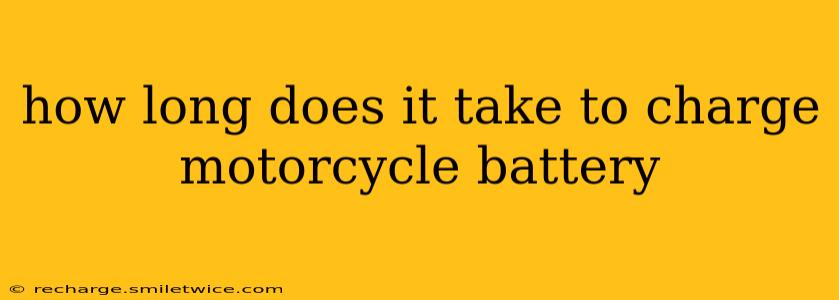How Long Does It Take to Charge a Motorcycle Battery?
Charging a motorcycle battery's duration depends on several factors, making it impossible to give a single definitive answer. This guide will break down the variables affecting charging time and offer helpful tips for optimal battery care.
What Factors Determine Motorcycle Battery Charging Time?
Several key factors influence how long your motorcycle battery takes to charge:
-
Battery Capacity (Amp-hours or Ah): A larger capacity battery (measured in amp-hours) will naturally take longer to charge than a smaller one. A 10Ah battery will generally charge faster than a 20Ah battery. This is the most significant factor.
-
State of Discharge (SoD): A completely depleted battery will require significantly more charging time than one that's only partially discharged. If your battery is severely drained, it might take considerably longer.
-
Charger Type and Output (Amperage): The type and amperage of your charger play a crucial role. A slow charger (e.g., a trickle charger at 0.8 amps) will take much longer than a fast charger (e.g., a 2-amp or higher charger). Using a charger with a higher amperage doesn't always mean faster charging; exceeding the battery's recommended charging rate can damage it.
-
Battery Age and Condition: An older or damaged battery may take longer to charge, or it might not accept a full charge, leading to shorter run times. Sulfation (a build-up of lead sulfate crystals) can hinder the charging process.
-
Ambient Temperature: Extreme temperatures (both hot and cold) can affect charging time and efficiency. Ideal charging temperatures are usually between 60°F and 80°F (15°C and 27°C).
How Long Does It Typically Take?
While specifics vary widely, here's a general guideline:
-
Trickle Charger (0.8-1 Amp): Expect a full charge to take 12-24 hours, or even longer for a deeply discharged battery. These chargers are gentle and ideal for long-term maintenance.
-
Standard Charger (2-5 Amps): A full charge typically takes 4-8 hours, assuming the battery isn't completely dead. Always refer to your charger's instructions for your specific battery.
-
Fast Charger (10 Amps or more): These can charge a battery in a couple of hours but should only be used cautiously and according to the manufacturer's instructions. Overcharging can severely damage your battery.
What is the best way to charge a motorcycle battery?
The best approach involves using a charger designed for motorcycle batteries, which usually offer various charging modes. Opt for a charger with a float mode, allowing the battery to remain connected indefinitely without overcharging. Always consult your motorcycle battery's manual for its recommended charging rate. Never exceed the recommended amperage.
Can I leave my motorcycle battery on the charger overnight?
Leaving a motorcycle battery on a float-type charger overnight is generally safe, provided the charger is designed for this purpose. However, it's advisable to check the battery's voltage periodically to ensure it's not overcharging.
How do I know when my motorcycle battery is fully charged?
Most chargers include a light or indicator that signals a full charge. If your charger doesn't have an indicator, you can use a multimeter to check the battery's voltage. A fully charged 12V motorcycle battery will typically register around 12.6-13.2 volts.
My motorcycle battery takes a long time to charge - what could be the problem?
If your motorcycle battery consistently takes an unusually long time to charge, or won't hold a charge, there could be several underlying issues, such as:
- Battery sulfation: This is a common problem in older batteries and can greatly reduce their ability to accept a charge.
- Internal damage: Internal shorts or other damage within the battery can hinder the charging process.
- Charger malfunction: The charger itself may be faulty or not providing the correct voltage or amperage.
If you suspect a problem with your battery, it's best to have it tested by a professional.
By understanding these factors and following safe charging practices, you can ensure your motorcycle battery is properly charged and ready for your next ride. Remember, always prioritize safety and consult your battery's and charger's manuals for specific instructions and recommendations.
